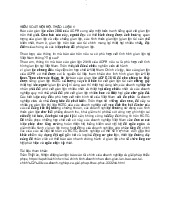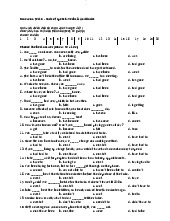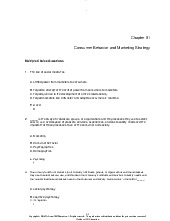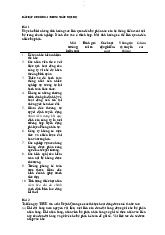

Preview text:
lOMoARcPSD|472 065 21 lOMoARcPSD|472 065 21
Name ________________________________________ Date __________________
Before Reading Genes: All in the Family All in the Family
Do you look a little like your mom? Or a lot like
your grandfather? Have you ever wondered why?
You can blame it all on your genes. Analyze Author’s Purpose
Writers decide which form of writing to use based on what information they by Robert Winston
want to tell their readers. Knowing an author’s purpose, or reason for writing,
helps you evaluate the information. Writers can write to narrate, to inform or Compre hension Coach
explain, to persuade or argue, to express feelings, or to tell how to do
something. In science writing, writers use key terms and facts to communicate important ideas.
A. Read the passage below. Identify the facts and key terms about genes. Write
the facts and key terms in the Main-Idea Tree. LOOK INTO THE TEXT What Is a Gene?
The word gene has several meanings, but in essence, a gene is an
instruction that tells your body how to work. The instruction is
stored as a code in the molecule DNA. MAIN-IDEA TREE Fact: Fact: What Is a Gene? Key Term: code Key Term: B. Answer the questions.
1. What is the author’s purpose for writing?
__________________________________________________________________________________________
__________________________________________________________________________________________
2. How does the author achieve his purpose? _____________________________________________
__________________________________________________________________________________________
__________________________________________________________________________________________
50 UNIT 2: Family Matters lOMoARcPSD|472 065 21
Name ________________________________________ Date __________________ FOCUS STRATEGY: Self-Question H Focus Strategy OW TO SELF-QUESTION
1. Ask Questions Pay attention to important ideas, text features, and diagrams.
2. Write Your Questions Write Who, What, Where, When, Why, and How questions.
3. Answer the Questions Use the text and visuals to help answer your questions.
A. Read the passage. Use the strategies above to self-question as you
read. Complete the chart below. Look Into the Text Where Do My Genes Come From?
Your genes come from your parents, theirs come from their parents,
and so on—all the way back to the first living thing that ever
existed. Genes are passed down through families, and that’s
why you probably look a bit like your parents. Physical
characteristics, like long eyelashes, red hair, freckles, or blue
eyes, run in families because they are controlled by genes. Type of Question Ask Your Questions Answer Your Questions Where?
Where do your genes come from? Why? What? How?
B. How did self-questioning help you understand the passage better?
_____________________________________________________________________________________
_____________________________________________________________________________________ UNIT 2: Family Matters 51



